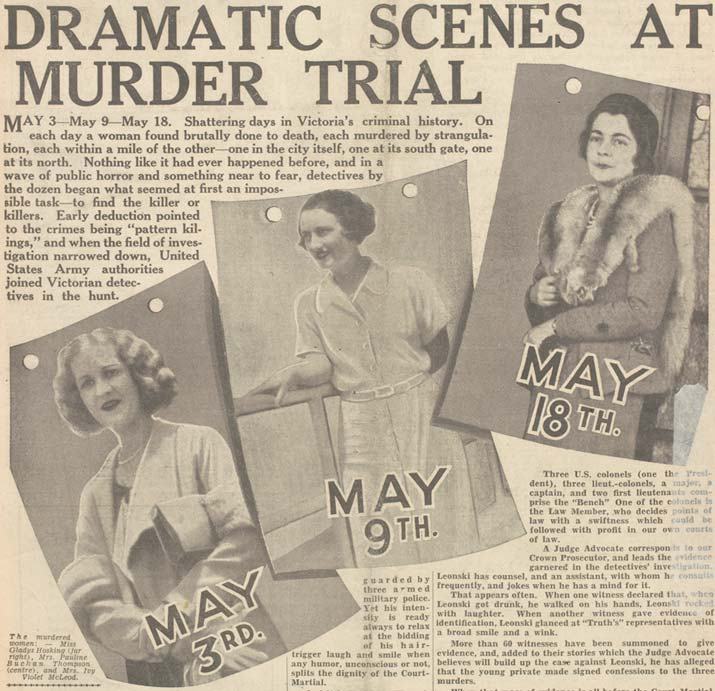
She had a lovely voice. I wanted that voice. She was leaving to go to her house and I did not want her to go. I grabbed her by the throat. I choked her; I choked her. (Edward Leonski, quoted from trial transcript, National Archives of Australia Barcode 101035 p364)
In early 1942 two very different American soldiers arrived in Australia as part of a surge of United States troops based in Australia to fight the war in the Pacific. Hayford Octavius Enwall was a lawyer who was working as the Chief Legal Officer of the US Army Services of Supply and Edward Joseph Leonski was a problematic, troubled soldier with the US 52nd Signal Battalion. By the end of the war Enwall left Australia a married man, having fallen in love with Jean Kennett – a poster girl for Australian army recruitment. Leonski on the other hand did not leave Australia alive, and was executed at Pentridge Prison in 1943 for the murders of three Melbourne women.
![Hayford Enwall and Jean Kennett on their wedding day, 25 August 1944. ANMM Collection ANMS0148[021] Hayford Enwall and Jean Kennett on their wedding day, 25 August 1944. ANMM Collection ANMS0148[021]](https://s3-ap-southeast-2.amazonaws.com/anmm-data/blog/2012/11/23/anms0148021.jpg)
Hayford Enwall and Jean Kennett on their wedding day, 25 August 1944. ANMM Collection Gift ANMS0148[021]
Leonski was only 24 at the time he ‘ran amuck’, the description he gives to his crimes in a letter written to a female correspondent while in gaol. Born in New Jersey in 1917, Leonski’s upbringing had been troubled. His family had a history of mental illness and two of his brothers had spent time in prison. As a soldier, Leonksi was well-known among his colleagues for heavy drinking and rowdy behaviour. He was often described as ‘burly’ and ‘powerfully built’ with a tendency for drunken aggression towards women. In 1941, while stationed with his unit in San Antonio, Texas, Leonski attempted to strangle a woman. Unfortunately his victim decided against pressing her assault charge, an action that would have ended his military career. It was under this dark cloud that, in January 1942, Leonski left for Melbourne where his problematic behaviour reached a tragic peak.
In Australia Leonski was stationed at Camp Pell, Royal Park, Melbourne, where he continued to drink fiercely. During this time he allegedly attempted to strangle and rape a young woman in her St Kilda flat, however she managed to flee. Then, on 3 May, the body of 40-year-old Ivy May McLeod was found in the doorway of a shop in Albert Park. Following this, on 9 May 31-year-old Pauline Thompson was found dead near a city boarding house. Mrs Gladys Hosking, 40, was next – discovered murdered on 18 May in Royal Park. All three women were throttled and though they were found with their clothes torn and bodies exposed, none were found to have been sexually assaulted.
Fear permeated the streets of Melbourne and in the press the deaths became known as the ‘Brownout Murders’, a reference to the unpopular wartime practice of reduced street lighting. Witness descriptions of a sinister American soldier did nothing to supress an already tense atmosphere in Australia where anti-US sentiments were on the rise. Discontent between American and Australian soldiers had already sparked over differences in pay scales, food rations, race relations and the attentions of Australian women.

Detail from a letter written to a woman by Leonski while in gaol, dated 3 August 1942. ANMM Collection 00017256
Through a combination of detective work and the evidence of a fellow soldier to whom he had confessed, Leonski was taken into custody on 22 May 1942 and it was within an atmosphere of sensitive political relations that the Australian Government took the unprecedented step of allowing the Americans to conduct the trial. It was also the first time a person had been tried in Australia by a military tribunal for a crime that violated civil law. A strong case was put forward by prosecutor Hayford Enwall who said in closing:
Now, Gentlemen, the 92nd Article of War states that the penalty for murder shall be one of two things, death or life imprisonment. I am fully conscious of the awful responsibility of saying that a human being has forfeited his right to live, but I do say to you – I say it in all humility – that Edward J. Leonski by the fiendish and atrocious quality of these three crimes has demonstrated himself to be a person unfit to continue to live. (Trial transcript, National Archives of Australia, Barcode 101035, p386)
Leonski was declared sane and sentenced to death. He was hanged on 3 November 1942 in Pentridge Prison and his remains were initially buried in Australia before being transferred to a military cemetery in Honolulu. Two years after the trial Enwall married Jean Kennett (1912 – 1990), a Lieutenant in the Australian Army Medical Women’s Service whose wartime service was immortalised in a recruitment poster (seen below) created by renown war artist Napier Waller.
The historic trial left the names of these two American soldiers imprinted on Australian history, in newspaper headlines, photographs and archives. Enwall and Leonski. The man who married an Australian woman, and the man who murdered three.
Penny Hyde, Curatorial Assistant
![WW2 recruitment poster featuring Jean Enwall (née Kennett), ANMM Collection ANMS0148[001] WW2 recruitment poster featuring Jean Enwall (née Kennett), ANMM Collection ANMS0148[001]](https://s3-ap-southeast-2.amazonaws.com/anmm-data/blog/2012/11/23/anms01480011.jpg)
WW2 recruitment poster featuring Jean Enwall (née Kennett), ANMM Collection ANMS0148[001]

